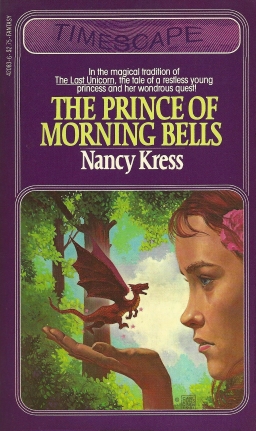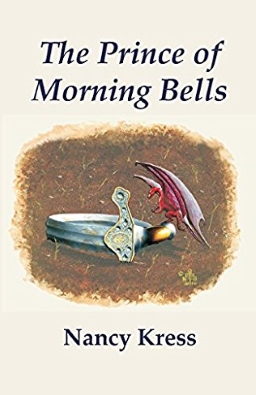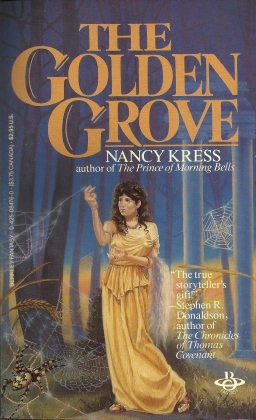A Fairy Tale At The Heart Of The World: The Prince of Morning Bells by Nancy Kress
 Contrary to conventional wisdom, sometimes a book’s cover gives matter enough for a fair judgment. The copy I read of Nancy Kress’ The Prince of Morning Bells is a 1981 first printing by Timescape; the book was reprinted in the year 2000 by Foxacre Press, and I learned from Black Gate supremo John O’Neill’s 2012 look at the title that a digital version came out in 2011. At any rate, the front cover of the Timescape edition promises: “In the magical tradition of The Last Unicorn, the tale of a restless young princess and her wondrous quest!” Parts of the blurb are only half-accurate, but the important part, the difficult-to-believe part, is quite correct. The Prince of Morning Bells is worth mentioning with The Last Unicorn, not just in terms of quality but in tone. It works with classic fantasy traditions, using a witty and often lightly-ironic style with a sprinkling of anachronism to tell a deep and profoundly moving tale. Kress has apparently noted the influence herself, though I don’t find the books excessively similar. Their bones are configured in different shapes. Distinctive, individual, The Prince of Morning Bells shows how a fantasy tale can transmute allegory into anti-allegory, telling a symbolic story that works as story while also working as symbol.
Contrary to conventional wisdom, sometimes a book’s cover gives matter enough for a fair judgment. The copy I read of Nancy Kress’ The Prince of Morning Bells is a 1981 first printing by Timescape; the book was reprinted in the year 2000 by Foxacre Press, and I learned from Black Gate supremo John O’Neill’s 2012 look at the title that a digital version came out in 2011. At any rate, the front cover of the Timescape edition promises: “In the magical tradition of The Last Unicorn, the tale of a restless young princess and her wondrous quest!” Parts of the blurb are only half-accurate, but the important part, the difficult-to-believe part, is quite correct. The Prince of Morning Bells is worth mentioning with The Last Unicorn, not just in terms of quality but in tone. It works with classic fantasy traditions, using a witty and often lightly-ironic style with a sprinkling of anachronism to tell a deep and profoundly moving tale. Kress has apparently noted the influence herself, though I don’t find the books excessively similar. Their bones are configured in different shapes. Distinctive, individual, The Prince of Morning Bells shows how a fantasy tale can transmute allegory into anti-allegory, telling a symbolic story that works as story while also working as symbol.
It is the story of Kirila, who begins as an eighteen-year-old princess discontented with what seems an increasingly unimportant life. She therefore decides to set out on a great Quest for the Heart of the World. She’s soon joined on her travels by a talking dog, Chessie, who claims to be a prince under a curse that can only be removed at the Heart of the World, which he tells her is to be found in the Tents of Omnium. Together they journey on, as Kirila encounters challenges and temptations; the story, which had opened on a comic note, gradually sounds bleaker tones and darker shades until, at the mid-point of the book, there is an unexpected structural turn. Kirila’s quest continues, but her resources and energy are taxed further than one might have imagined. The promised happy ending seems distant; and indeed the conclusion, although everything promised, is at the same time more equivocal than one might have imagined. Yet also satisfying, with real wisdom gained, Kirila thoroughly changed and developed, and a sense of both mystery and high majesty overriding all.
The book’s a fairy tale as much as fantasy, and if in the beginning it seems like a sending-up of fairy-tale cliches, it quickly grows more serious. As Kirila matures in the course of her adventures the quest gains in emotional intensity, giving the plot its centre without becoming episodic. Structurally, the book’s clever; although it divides into two halves, it’s so much of a piece it avoids a feeling of easy symmetry. Instead the midpoint does what a good midpoint’s supposed to, initiating the falling action in an unexpected way, leading through an increasing emotional intensity to an inevitable yet unpredictable conclusion. Kirila becomes an everywoman whose journey is a symbolic progress through life, yet if she begins as a generic spunky red-haired princess with a temper, she swiftly becomes an individual with distinctive gifts and flaws. While the quest defines the book, the shape of the quest follows the shape of her choices, prompted by who she is and what she wants. Fairy tale and characterisation combine.
This works because Kress has a mastery of style that lets her mix and contrast tones comic, romantic, tragic, and ironic, in sequence or all at once. Mundane scenes and description follow and are followed by glimpses of magic; and both gain. Here are two consecutive paragraphs from near the centre of the book, when Kirila takes part in a feast at a castle:
There was dancing, and feasting, and much toasting in wine and ale, the latter followed by a loud sing-along in which the nobility and the manor serfs, who had been provided with their own picnic in honor of the occasion, all joined in together. Kirila floated through the day, beautiful in a low-cut white velvet gown with a long train, that kept winding itself around her ankles like an affectionate serpent. Her red hair was caught up at each side in two braided loops tied with white satin ribbons. Tackma had loaned her the silver filigree crown, and under it her face had the same blurred brilliance, giving back the sunlight in a glittering cloud with no sharp edges. She smiled at everyone, and started little misty sentences she didn’t finish, and drank seven goblets of wine.
Only one moment stood out clearly. Toward late afternoon the knights had boisterously rigged up an impromptu joust, and Kirila sat on the ground with the other ladies, noisily cheering them on, oblivious of grass stains. As she turned to set her goblet on a convenient rock, a small red speck dropped out of the sky and perched on the rock first. Kirila hiccupped in surprise; she recognized it from Chessie’s descriptions as a wigyn. No more than two inches long, the wigyn had the fragile, finished perfection of the miniature. A tiny arching body the crimson of autumn maples ended in a tail pointed as a shard of diamond. Miniature fierce claws gripped the rock. The wigyn’s eyes, flecks of yellow light, gazed at her from above transparent, crimson veined wings. But what had made Kirila gasp was that around its neck the wigyn wore an impossibly small collar, and worked on the collar in hairline tracings of gold was the ancient rune that represented a tent.
The wigyn soon vanishes, and events whirl Kirila past the collar that seems to refer to the Tents of Omnium. What I want to point out here is the way in which the moment of quasi-revelation is worked into a mundane and even humorous scene. Look at the first sentence in the first quoted paragraph: the opening clauses set up a near-stately rhythm which is shifted to self-parody by the long clause right after. But the comedic effect is, I feel, modulated by the image of “the nobility and the manor serfs,” at once precise, prosaic, and hinting at class distinctions that shape the society of the story. On the other hand, the image of Kirila’s gown winding about her “like an affectionate serpent” sets up the wyrm-like wigyn of the next paragraph while also being a suitably friendly-sounding simile for an afternoon that’s overall pleasant. And yet the afternoon’s also notably indistinct, recalled as if through a drunken haze: Kirila’s face is “blurred brilliance” and “a glittering cloud with no sharp edges.” Beautiful, then, but lacking hardness; the first adjective describing the “little misty sentences she didn’t finish” implies a girlishness and (as things turn out) a potential lack of sticktoitiveness, just as the repetitive cadence of this last sentence echoes the repetition of the first, and the comic precision of “seven goblets of wine” finishes the paragraph on a note of gentle comedy.
 Contrasting all this, the one clear moment, is the wigyn. Its claws may be tiny, but they’re fierce. We’ll find out later in the book the metaphorical significance of the “finished perfection of the miniature,” and why the tiny dragon’s being compared to a tiny painting; enough to say that paintings and art make a recurring motif in the book, whether as heraldry or statuary or designs for a tombstone. The point is that it’s a hard bright moment of revelation, coming among grass stains and hiccups; it is a small and perfect sign of Kirila’s quest, set among the hazy memories of an afternoon party. Among mists and clouds are the bright precision of autumn maples and diamond chips. Note that just a couple pages earlier, there was a reference to “the scarlet and lemon days of late autumn.” Which is to say that the crimson scales and yellow eyes of the wigyn tie it to the world and the year.
Contrasting all this, the one clear moment, is the wigyn. Its claws may be tiny, but they’re fierce. We’ll find out later in the book the metaphorical significance of the “finished perfection of the miniature,” and why the tiny dragon’s being compared to a tiny painting; enough to say that paintings and art make a recurring motif in the book, whether as heraldry or statuary or designs for a tombstone. The point is that it’s a hard bright moment of revelation, coming among grass stains and hiccups; it is a small and perfect sign of Kirila’s quest, set among the hazy memories of an afternoon party. Among mists and clouds are the bright precision of autumn maples and diamond chips. Note that just a couple pages earlier, there was a reference to “the scarlet and lemon days of late autumn.” Which is to say that the crimson scales and yellow eyes of the wigyn tie it to the world and the year.
The book’s style and structure harmonise in this way all through the story. It’s a remarkably deft performance. Interestingly, while Kirila’s quest doesn’t shy away from violence, it resolutely avoids anything one might call grimdark — and still feels anchored in reality. It’s the sort of book that reminds one that a life can be filled with very many things beside war; that you can live through a complete emotional range while avoiding the merely brutal. Or, to put it another way, brutality can come in many flavours, of which overt violence is only one, and not necessarily the most dramatically powerful.
This comes out because the form of the story is highly symbolic, even allegoric — though I’d argue the fantasy of the story transmutes the allegory into something greater and deeper. To be precise about these things: an allegory is a story in which everything in the story has a specific double meaning. For example, Bunyan’s Pilgrim’s Progress tells the story of a soul’s journey through the world to heaven by telling the story of a man, Christian, who sets out on a journey to the Celestial City, encounters various allies, obstacles, and monsters, and finally comes to his destination; the second half of the book then shows his wife and children setting out after him, as though describing a community’s struggle after holiness in contrast to an individual’s. The point is that along the way Christian meets entities that represent a specific concept — Mr. Worldly Wiseman, the giant Despair,a false guide called Flatterer, and so forth — so that Christian’s journey to the Celestial City is a kind of roman a clef for a soul’s journey to heaven.
 Kirila’s journey is a similar quest through the world. Like Christian, she meets allies and enemies and obstacles, and as in The Pilgrim’s Progress these all have some kind of double meaning. But the people she meets aren’t as specific as Bunyan’s allegory. You can see generally what they’re doing and what they represent, but there isn’t the sense of reading a coded tract that allegory sometimes creates. When Kirila encounters a mysterious society called Quirks, with four clans of Up, Down, Strange, and Charm, you can see that they’re named for subatomic particles; and when she finds that they’re busy researching ancient inscriptions to properly classify anything in the world, you get a sense that they represent the worldview of scientific dryasdusts. But they’re also more than that, somehow. The way in which Kress imagines them, formal to the point of obsequiousness but also argumentative and repressing old quarrels, gives them not just individuality but a number of other symbolic aspects. Even their name suggests the unusual, the absurd. They’re largely one thing, but not entirely; there are countercurrents and odd echoes.
Kirila’s journey is a similar quest through the world. Like Christian, she meets allies and enemies and obstacles, and as in The Pilgrim’s Progress these all have some kind of double meaning. But the people she meets aren’t as specific as Bunyan’s allegory. You can see generally what they’re doing and what they represent, but there isn’t the sense of reading a coded tract that allegory sometimes creates. When Kirila encounters a mysterious society called Quirks, with four clans of Up, Down, Strange, and Charm, you can see that they’re named for subatomic particles; and when she finds that they’re busy researching ancient inscriptions to properly classify anything in the world, you get a sense that they represent the worldview of scientific dryasdusts. But they’re also more than that, somehow. The way in which Kress imagines them, formal to the point of obsequiousness but also argumentative and repressing old quarrels, gives them not just individuality but a number of other symbolic aspects. Even their name suggests the unusual, the absurd. They’re largely one thing, but not entirely; there are countercurrents and odd echoes.
As Kirila goes on her quest, encountering love and violence and everyday life, the lessons she learns from what she finds are more multi-faceted than they at first appear. They shape her more than easy allegory would allow. Kirila and Chessie are individuals; if Chessie’s a mentor-figure who constantly and faithfully reminds Kirila of her quest with songs and stories, he’s also a man cursed to live as a talking purple dog. There’s a dreamlike depth to the book, instead of the linear correspondences of the typical allegory. There’s also a distinct theme, something more complex than a moral but not as precisely or logically defined as a philosophy, and the events that present the theme are rich enough in imagery that they have a life beyond their conscious designs.
This is something, I feel, that fantasy does well. It recalls to me the work of George MacDonald, specifically in something like Lilith or Phantastes. Both of them tell highly symbolic stories with fairly specific meanings that inhabit the grey space between allegory and symbolic drama. Some of Oscar Wilde’s fairy tales do the same general thing in a much briefer space: the theme of the story has a specificity that you can’t avoid, but a richness that leavens the directness of the point. The Prince of Morning Bells transcends all allegory at the end, reaching a conclusion filled with awe and sorrow that leaves things open to interpretation. It’s a rich conclusion to a rich and lovely book.
I’ve said here before that the flood of fantasy in the 1980s produced some fascinating and under-appreciated work. The Prince of Morning Bells is a fine example. It was Kress’s debut; she wrote a few more fantasy novels over the following years (John O’Neill has a consideration of them here), but has gained more renown for her science fiction work, having won six Nebulas and two Hugos for her novellas and shorter fiction. I’d like to think her success will lead to a greater appreciation of her first novel. Wise and wondrous, The Prince of Morning Bells greatly impressed me: a fairy tale with a meaningful vision of what lies at the heart of the world.
Matthew David Surridge is the author of “The Word of Azrael,” from Black Gate 14. You can buy his first collection of essays, looking at some fantasy novels of the twenty-first century, here. His second collection, looking at some fantasy from the twentieth century, is here. You can find him on Facebook, or follow his Twitter account, Fell_Gard.